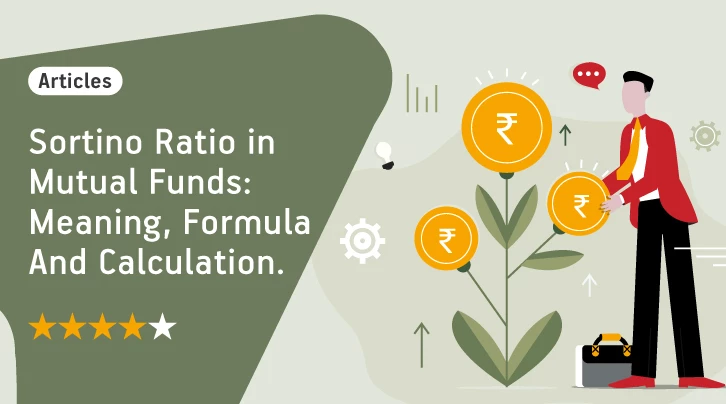What is Sortino Ratio?
Sortino ratio is a statistical tool useful for evaluating the performance of mutual funds by considering the downward deviation. Therefore, the ratio is valuable for identifying the risk-adjusted returns from a specific investment scheme. It can help investors analyze the risk in a better way instead of simply concentrating on the returns as per total volatility.
Calculating the Sortino ratio requires investors to check the downward volatility. Therefore, it offers an accurate representation of a mutual fund’s performance after adjusting all possible risks. The primary objective of the ratio is to use the downward deviation for extracting the harmful volatility out of the total volatility.
What is Sortino Ratio in Mutual Funds?
Sortino ratio is a metric used to determine the risk-adjusted performance of an investment product. Particularly in mutual funds, it considers the downside risk. The Sharpe ratio considers total volatility whereas the Sortino ratio focuses on the negative volatility also known as the downside risk.
Formula and Calculation of Sortino Ratio
Sortino Ratio = (Rp – rf) / σd
Rp = actual or expected return on portfolio
rf = risk-free rate of return
σd = standard deviation of the downside
How to Interpret Sortino Ratio?
Investors prefer investing in mutual funds with a higher return per unit of downside risk. Funds with a lower Sortino ratio will offer lower returns per unit of downside risk. Therefore, a higher Sortino ratio will offer better returns as compensation for the risk taken by investors.
By offering a clear picture of an investment’s return, the ratio enables improved decision-making. Moreover, investors concerned about downward volatility can focus on this ratio because positive fluctuations can be profitable for them. Therefore, focusing on the downside risk is even more significant than the total volatility in the market.
Example of Sortino Ratio
|
Fund A |
Fund B |
Expected Returns (Rp) |
15% |
20% |
Risk-free rate of return (rf) |
8% |
8% |
Downside deviation (σd) |
5% |
10% |
Sortino Ratio |
1.4 |
1.2 |
A higher Sortino ratio is always better for mutual fund investments. Therefore, fund A is likely to offer better returns per unit of a specific risk than fund B. Moreover, fund A will also be better at avoiding losses than fund B.
Importance of Sortino Ratio
The significance of the Sortino ratio in mutual funds is as follows:
-
The statistical tool is ideal for comparing mutual funds over a specific point in time.
-
It is useful for tackling the limitation of standard deviation and evaluating the possible risk in a risk and return trade-off.
-
Measuring the downward deviation is valuable for recognizing the difference between good and bad.
-
The Sortino ratio can help investors with particular goals to make accurate investment decisions.
-
Fund managers use the Sortino ratio to measure accurate returns as per market volatility by ignoring all positive variances.
Also Read – Risk Adjusted Returns
What can Sortino Ratio tell you?
The Sortino ratio can assist portfolio managers, analysts, and investors in measuring the return of a mutual fund amidst a specific bad risk level. This ratio only considers the downside deviation to the measure of risk. Therefore, it can successfully address the problem with the help of standard deviation or total risk. The Sortino ratio is particularly important because upside volatility isn’t considered valuable by investors, even though it is extremely beneficial.
The Sortino ratio is often an important consideration when choosing the right mutual fund to invest in. Any mutual fund with a Sortino ratio between 1 and 2 is regarded as ideal. But at times, the Sortino ratio might go up to 3, which is exceptional. If the Sortino ratio is negative, you should know that no rewards are available for the risks undertaken.
Limitations of Sortino Ratio
Like other ratios used to analyze mutual funds, the Sortino ratio is also based on historical returns. Therefore, the Sortino ratio cannot be considered a reliable indicator for future outcomes. Moreover, the Sortino ratio will fail to deliver meaningful outcomes when interpreted in isolation.
Additionally, the Sortino ratio focuses on the downside deviation method for evaluating risk. Therefore, the shortcomings can have a drastic influence on it. For instance, a bad risk or observation should be present for the outcomes to be statistically unworthy of analysis in case of a downside deviation.
Furthermore, investors need to measure the Sortino ratio in accordance with something while managing their portfolio. The risk tolerance level and investment horizon should be brought into the context while checking the Sortino ratio.
Difference Between Sortino Ratio and Sharpe Ratio
The Sortino ratio is a type of Sharpe ratio. But the Sortino ratio considers the negative or downside return. The Sharpe ratio delivers positive returns to investors by punishing investments for good risk.
Investors can pick which ratio to use depending on whether they want to concentrate on standard or downward deviation. A few key differences between the Sortino and Sharpe ratios are as follows:
Criteria |
Sortino Ratio |
Sharpe Ratio |
Evaluates |
Downside risk from investment returns |
Volatility of investment returns |
Formula |
(Rp – Rf)/SD of bad returns |
(Rp – Rf)/SDp |
Measuring Portfolio |
High Volatility |
Low Volatility |
Risk |
Looks into downside risk only |
Looks into total volatility, including both upside and downside risk |
Denominator |
Standard Deviation of bad returns |
Standard Deviation of the whole portfolio |
Please note –
Rp = Average returns of the investment
Rf = Returns of a risk-free investment
SDp = Standard deviation of the portfolio
Mutual Fund investments are subject to market risks, read all scheme related documents carefully.





 1800-270-7000
1800-270-7000




